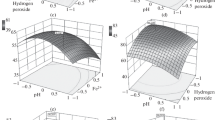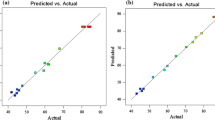Abstract
The study examined solar irradiation for enhancement of Fenton treatment of pesticide chlorpyrifos wastewater. Optimization of the process was achieved by employing the central composite design (CCD). Total organic removal (TOC) removal of 89.2 % was obtained under the optimized conditions (pH 3, H2O2/COD 2.25 and H2O2/Fe2+ 10 molar ratios and 60 min reaction time). The improvement of biodegradability (BOD5/COD ratio) index from 0 to 0.41 obviously indicated that biological treatment could be applied after pretreatment for complete treatment of the wastewater. The experimental results and model prediction had an error less than 5 % owing to the close data obtained. Solar irradiated Fenton treatment is effective for the pretreatment of pesticide chlorpyrifos wastewater before biological treatment maybe applied.






Similar content being viewed by others
References
Affam AC, Chaudhuri M, Kutty SRM, Muda K (2014) UV Fenton and sequencing batch reactor treatment of chlorpyrifos, cypermethrin and chlorothalonil pesticide wastewater. Int Biodeter Biodegrad J 93:195–201
Al-Momani F, Touraud E, Degorce-Dumas JR, Roussy J, Thomas O (2002) Biodegradility enhancement of textile dyes and textile wastewater by VUV photolysis. J Photochem Photobiol A Chem 153(1–3):191–197
APHA (2005) Standard methods for the examination of water and wastewater, 21st edn. American Public Health association, American Water Works Association and Water Environment Federation, Washington DC
Armenta S, Quintas G, Garrigues S, De la Guardi M (2005) A validated and fast procedure for FTIR determination of cypermethrin and chlorpyrifos. Talanta 67:634–639
Arslan-Alaton I, Tureli G, Olmez-Hanci T (2009) Treatment of azo dye production wastewaters using photo-Fenton-like advanced oxidation processes: optimization by response surface methodology. J Photochem Photobiol 202(2–3):142–153
Badawy MI, Ghaly MY, Gad-Allah TA (2006) Advanced oxidation processes for the removal of organophosphorus pesticides from wastewater. Desalination 194(1–3):166–175
Benkelberg HJ, Warnek P (1995) Photodecomposition of iron(III) hydroxo and sulfato complexes in aqueous solution: wavelength dependence of OH and SO4-quantum yields. J Phys Chem 99:5214–5221
Bezerra MA, Santelli RE, Oliviera EP, Villar LS, Escaleira LA (2008) Response surface methodology (RSM) as a tool for optimization in analytical chemistry. Talanta 76(5):965–977
Casero I, Sicilia D, Rubio S, Bendito DF (1997) Chemical degradation of aromatic amines by Fenton reagent. Water Res 31(8):1985–1995
Chamarro E, Marco A, Esplugas S (2001) Use of Fenton reagent to improve organic chemical biodegradability. Water Res 25(4):1047–1051
Cole TB, Walter BJ, Shih DM, Tward AD, Lusis AJ, Timchalk C, Richter RJ, Costa LG, Furlong CE (2005) Toxicity of chlorpyrifos and chlorpyrifos oxon in a transgenic mouse model of the human paraoxonase (PON1) Q192R polymorphism. Pharm Gen 15:589–598
Devi LG, Murthy BN, Kumar S (2009) G. Photocatalytic activity of V5+, Mo6+ and Th4+ doped polycrystalline TiO2 for the degradation of chlorpyrifos under UV/solar light. J Mol Catal A Chem 308(1–2):174–181
Elmolla E, Chaudhuri M (2009a) Optimization of Fenton process for treatment of amoxicillin, ampicillin and cloxacillin antibiotics in aqueous solution. J Hazard Mater 170(2–3):666–672
Elmolla E, Chaudhuri M (2009b) Degradation of amoxicillin, ampicillin, and cloxacillin antibiotics in aqueous solution by the photo Fenton process. J Hazard Mater 172(2–3):1476–1481
Esplugas S, Gimenez J, Contreras S, Pascual E, Rodriguez M (2002) Comparison of different advanced oxidation processes for phenol degradation. Wat Res 36(4):1034–1042
Evgenidou E, Konstantinou I, Fytianos K, Poulios I, Albanis T (2007) Photocatalytic oxidation of methyl parathion over TiO2 and ZnO suspensions. Catal Today 124(3–4):156–162
Ghafari S, Aziz HA, Isa MH, Zinatizadeh AA (2009) Application of response surface methodology (RSM) to optimize coagulation flocculation treatment of leachate using poly-aluminium chloride (PAC) and alum. J Hazard Mater 163(2–3):650–656
Griffin P, Mason H, Heywood K, Cocker J (1999) Oral and dermal absorption of chlorpyrifos: a human volunteer study. Occup Environ Med 56(1):10–13
Hua F, Yunlong Y, Xiaoqiang C, Xiuguo W, Xiaoe Y, Jingquan Y (2009) Degradation of chlorpyrifos in laboratory soil and its impact on soil microbial functional diversity. J Environ Sci 21(3):380–386
Ismail M, Khan HM, Sayed M, Cooper WJ (2013) Advanced oxidation for the treatment of chlorpyrifos in aqueous solution. Chemosphere 93(4):645–651
Joseph JM, Destaillats H, Hung HM, Hoffmann MR (2000) The sonochemical degradation of azobenzene and related azo dyes: rate enhancements via Fenton’s reactions. J Phy Chem 104(2):301–307
Kang YW, Hwang KY (2000) Effects of reaction conditions on the oxidation efficiency in the Fenton process. Wat Res 34(10):2786–2790
Kang YW, Cho MJ, Hwang KY (1999) Correction of hydrogen peroxide interference on standard chemical oxygen demand test. Wat Res 33(5):1247–1251
Katsumata H, Kaneco S, Suzuki T, Ohta K, Yobiko Y (2005) Degradation of Linuron in aqueous solution by the photo-Fenton reaction. Chem Eng J 108(3):269–276
Kavitha V, Palanivelu K (2005) Destruction of cresols by Fenton oxidation process. Wat Res 39(13):3062–3072
Khuri AI, Cornell JA (1996) Response surfaces: designs and analyses, 2nd edn. Marcel Dekker Inc., New York
Kwon BG, Lee DS, Kang N, Yoon J (1999) Characteristics of pchlorophenol oxidation by Fenton’s reagent. Water Res 33:2110–2118
Mailhot G, Astruc M, Bolte M (1991) Degradation of tributyltin chloride in water photoinduced by iron (III). Appl Organomet Chem 13(1):53–61
McEwen L, Deweese L, Schladweiler P (1986) Bird predation on cutworms (Lepidoptera: noctuidae) in wheat fields and chlorpyrifos effects on brain cholinesterase activity. Environ Entomol 15(1):147–151
Muda K, Aris A, Salim MR, Ibrahim Z, Yahya A, van Loosdrecht MCM, Ahmad A, Nawahwi MZ (2010) Development of granular sludge for textile wastewater treatment. Wat Res 44(15):4341–4350
Mullen CA, Frazier M, Frazier JL, Ashcraft S, Simonds R, van Engelsdorp D, Pettis JS (2010) High levels of miticides and agrochemicals in North American Apiaries: implications for honey bee health. PLOS one. doi:10.1371/journal.pone.0009754
Oller I, Malato S, Sanchez-Perez J (2011) Combination of advanced oxidation processes and biological treatments for wastewater decontamination A review. Sci Total Environ 409(20):4141–4166
Pera-Titus M, García-Molina V, Baños MA, Giménez J, Esplugas S (2004) Degradation of chlorophenols by means of advanced oxidation processes: a general review. Appl Catal B 47(4):219–256
Pignatello J (1992) Dark and photo assisted iron (3+)-catalyzed degradation of chlorophenoxy herbicides by hydrogen peroxide. Environ Sci Technol 26(5):944–951
Pignatello J, Sun Y (1995) Complete oxidation of metolachlor and methyl parathion in water by the photoassisted Fenton reaction. Wat Res 29(8):1837–1844
Samadi MT, Khodadai M, Rahmani AR (2011) The comparison of advanced oxidation process and chemical coagulation for the removal of residual pesticides from water. Res J Environ Sci 5:817–826
Samet Y, Agengui L, Abdelhédi R (2010a) Anodic oxidation of chlorpyrifos in aqueous solution at lead dioxide electrodes. J Electroanal Chem 650(1):152–158
Samet Y, Agengui L, Abdelhédi R (2010b) Electrochemical degradation of chlorpyrifos pesticide in aqueous solutions by anodic oxidation at boron-doped diamond electrodes. Chem Eng J 161(1–2):167–172
Scott J, Ollis D (1995) Integration of chemical and biological oxidation processes for wastewater treatment: review and recommendations. Environ Prog 14(2):68–103
Serrano R, Hernández F, Peña JB, Dosda V, Canales J (1995) Toxicity and bioconcentration of selected organophosphorus pesticides in mytilus galloprovincialis and venus gallina. Arch Environ Contam Toxicol 29(3):284–290
Serrano R, Hernández F, Lopez FJ, Peña JB (1997) Bioconcentration and depuration of chlorpyrifos in the marine Mollusc Mytilus edulis. Arch Environ Contam Toxicol 33(1):47–52
Sherrard RM, Bearr JS, Murray-Gulde CL, Rodgers JH Jr, Shah YT (2004) Feasibility of constructed wetlands for removing chlorothalonil and chlorpyrifos from aqueous mixtures. Environ Pollut 127(3):385–394
Sinnaraprasat S, Fongsatitkul P (2011) Optimal condition of Fenton’s reagent to enhance the alcohol production from palm oil mill effluent (POME). Int J Thai Soc High Edu Environ 4(2):9–16
Sivagami K, Vikraman B, Krishna RR, Swaminathan T (2015) Chlorpyrifos and Endosulfan degradation studies in an annular slurry photo reactor. Ecotoxicol Environ Saf. doi:10.1016/j.ecoenv.2015.08.015
Talinli I, Anderson GK (1992) Interference of hydrogen peroxide on the standard COD test. Water Res 26(1):107–110
Tang WZ, Huang P (1997) Stoichiometry of Fenton`s reagent in the oxidation of chlorinated aliphatic pollutants. Environ Technol 18(1):13–23
Tang W, Tassos S (1997) Oxidation kinetics and mechanisms of trihalomethanes by Fenton reagent. Wat Res 31(5):1117–1125
Tengrui L, Al-Harbawi A, Jun Z, Bo LM (2007) The effect and its influence factors of the Fenton process on the old landfill leachate. J Applied Sci 7(5):724–727
World Health Organization (2009) Chlorpyrifos WHO speculations and evaluations for public health pesticides. http://www.who.int/whopes/quality/Chlorpyrifos_WHO_specs_eval_Mar_2009.pdf. Accessed 12 Nov 2014
You Y, Zhao H, Vance GF (2002) Adsorption of dicamba (3,6-dichloro-2-methoxy benzoic acid) in aqueous solution by calcined-layered double hydroxide. Appl Clay Sci 21(5–6):217–226
Zapata A, Oller I, Bizan E, Sanchez PJA, Malnado MI, Malato S (2009) Evaluation of operational parameters involved in solar photo-Fenton degradation of a commercial pesticide mixture. Catal Today 144(1–2):94–99
Zhang Y, Xiao Z, Chen F, Ge Y, Wu J, Hu X (2010) Degradation behavior and products of malathion and chlorpyrifos spiked in apple juice by ultrasonic treatment. Ultrason Sonochem 17(1):72–77
Acknowledgments
The authors are indeed grateful to Universiti Teknologi PETRONAS for the provision of laboratory equipments for the work.
Author information
Authors and Affiliations
Corresponding author
Rights and permissions
About this article
Cite this article
Augustine, A.C., Chaudhuri, M. & Hetrick, K. Optimization of solar irradiated Fenton treatment of pesticide chlorpyrifos wastewater by response surface methodology. Environ Earth Sci 75, 840 (2016). https://doi.org/10.1007/s12665-016-5510-z
Received:
Accepted:
Published:
DOI: https://doi.org/10.1007/s12665-016-5510-z




